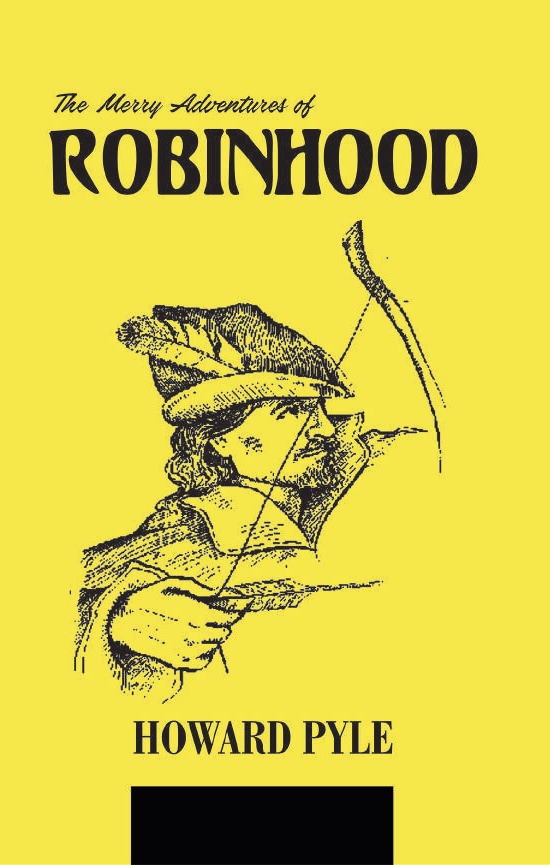TheIndianBookStore
THE MERRY ADVENTURES OF ROBIN HOOD By HOWARD PYLE
THE MERRY ADVENTURES OF ROBIN HOOD By HOWARD PYLE
Regular price
Rs. 389.00
Regular price
Rs. 899.00
Sale price
Rs. 389.00
Unit price
per
Shipping calculated at checkout.
Couldn't load pickup availability
The Merry Adventures of Robin Hood of Great Renown in Nottinghamshire is an 1883 novel by the American illustrator and writer Howard Pyle. Consisting of a series of episodes in the story of the English outlaw Robin Hood and his band of Merry Men, the novel compiles traditional material into a coherent narrative in a colorful, invented "old English" idiom that preserves some flavor of the ballads, and adapts it for children. The novel is notable for taking the subject of Robin Hood, which had been increasingly popular through the 19th century, in a new direction that influenced later writers, artists, and filmmakers through the next century.[1]Pyle had been submitting illustrated poems and fairy tales to New York publications since 1876, and had met with success. The Merry Adventures of Robin Hood was the first novel he attempted. He took his material from Middle Age ballads and wove them into a cohesive story, altering them for coherence and the tastes of his child audience. For example, he included "Robin Hood and the Curtal Friar" in the narrative order to reintroduce Friar Tuck. He needed a cooperative priest for the wedding of outlaw Allan a Dale (Pyle's spelling of the original Alan-a-Dale) to his sweetheart Ellen. In the original "A Gest of Robyn Hode", the life is saved of an anonymous wrestler who had won a bout but was likely to be murdered because he was a stranger. Pyle adapted it and gave the wrestler the identity of David of Doncaster, one of Robin's band in the story "Robin Hood and the Golden Arrow." In his novelistic treatment of the tales, Pyle thus developed several characters who had been mentioned in only one ballad, such as David of Doncaster or Arthur a Bland.
Pyle's book continued the 19th-century trend of portraying Robin Hood as a heroic outlaw who robs the rich to feed the poor; this portrayal contrasts with the Robin Hood of the ballads, where the protagonist is an out-and-out crook, whose crimes are motivated by personal gain rather than politics or a desire to help others.[1] For instance, he modified the ballad "Robin Hood's Progress to Nottingham", changing it from Robin killing fourteen foresters for not honoring a bet to Robin defending himself against a band of armed robbers. Pyle has Robin kill only one man, who shoots at him first. Tales are changed in which Robin steals all that an ambushed traveler carried, such as "Robin Hood and the Bishop of Hereford", so that the victim keeps a third and another third is dedicated to the poor.
Pyle did not have much concern for historical accuracy, but he renamed the queen-consort in the story "Robin Hood and Queen Katherine" as Eleanor (of Aquitaine). This made her compatible historically with King Richard the Lion-Hearted, with whom Robin eventually makes peace.
The novel was first published by Scribner's in 1883, and met with immediate success,[1] ushering in a new era of Robin Hood stories. It helped solidify the image of a heroic Robin Hood, which had begun in earlier works such as Walter Scott's 1819 novel Ivanhoe. In Pyle's wake, Robin Hood has become a staunch philanthropist protecting innocents against increasingly aggressive villains.[1] Along with the publication of the Child Ballads by Francis James Child, which included most of the surviving Robin Hood ballads, Pyle's novel helped increase the popularity of the Robin Hood legend in the United States. The Merry Adventures also had an effect on subsequent children's literature. It helped move the Robin Hood legend out of the realm of penny dreadfuls and into the realm of respected children's books.[2] After Pyle, Robin Hood became an increasingly popular subject for children's books: Louis Rhead's Bold Robin Hood and His Outlaw Band (1912) and Paul Creswick's Robin Hood (1917), illustrated by Pyle's pupil N. C.
Pyle's book continued the 19th-century trend of portraying Robin Hood as a heroic outlaw who robs the rich to feed the poor; this portrayal contrasts with the Robin Hood of the ballads, where the protagonist is an out-and-out crook, whose crimes are motivated by personal gain rather than politics or a desire to help others.[1] For instance, he modified the ballad "Robin Hood's Progress to Nottingham", changing it from Robin killing fourteen foresters for not honoring a bet to Robin defending himself against a band of armed robbers. Pyle has Robin kill only one man, who shoots at him first. Tales are changed in which Robin steals all that an ambushed traveler carried, such as "Robin Hood and the Bishop of Hereford", so that the victim keeps a third and another third is dedicated to the poor.
Pyle did not have much concern for historical accuracy, but he renamed the queen-consort in the story "Robin Hood and Queen Katherine" as Eleanor (of Aquitaine). This made her compatible historically with King Richard the Lion-Hearted, with whom Robin eventually makes peace.
The novel was first published by Scribner's in 1883, and met with immediate success,[1] ushering in a new era of Robin Hood stories. It helped solidify the image of a heroic Robin Hood, which had begun in earlier works such as Walter Scott's 1819 novel Ivanhoe. In Pyle's wake, Robin Hood has become a staunch philanthropist protecting innocents against increasingly aggressive villains.[1] Along with the publication of the Child Ballads by Francis James Child, which included most of the surviving Robin Hood ballads, Pyle's novel helped increase the popularity of the Robin Hood legend in the United States. The Merry Adventures also had an effect on subsequent children's literature. It helped move the Robin Hood legend out of the realm of penny dreadfuls and into the realm of respected children's books.[2] After Pyle, Robin Hood became an increasingly popular subject for children's books: Louis Rhead's Bold Robin Hood and His Outlaw Band (1912) and Paul Creswick's Robin Hood (1917), illustrated by Pyle's pupil N. C.


